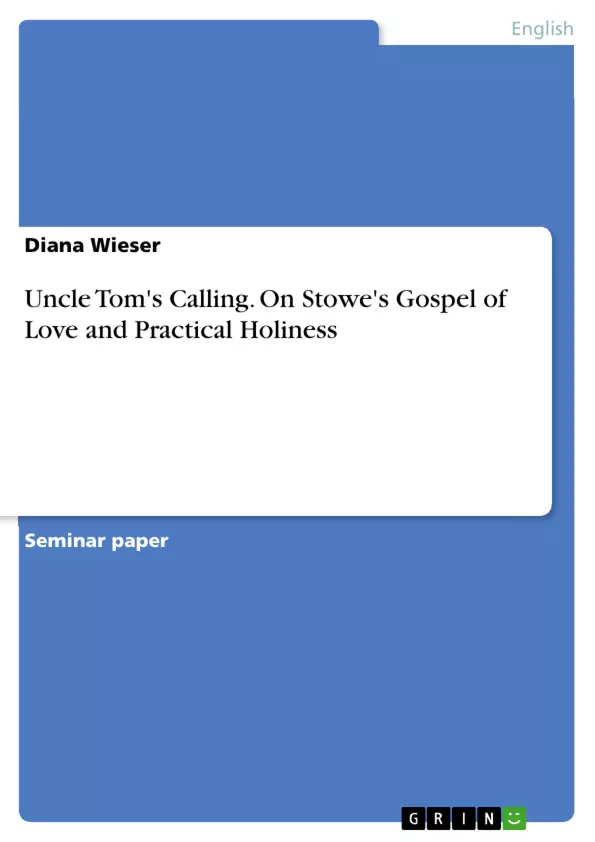Harriet Beecher Stowe′s widely acknowledged novel Uncle Tom′s Cabin (1852) in two volumes has been subjected to much controversy as regards its protagonist′s role as a Christian martyr. I found critics to hold the assumption that as Tom does not assume an active role against slavery but practices non-aggression according to the biblical Gospel of Love including love of one′s enemy, he does nothing, really, to change the slaves′ condition.
However, passive resistance is unanimously agreed to be an effective form of resistance, thus I venture to propose that saints and martyrs do in fact bring about a change by their incomprehensible consent to sacrifice for others or for a higher ideal. Tom does startle, irritate, penetrate, and shake up the people he comes into contact with: Significantly, all of them are reminded of their childhood, when the gospel was still close to their hearts, and they realize the wish to believe in God is preserved, ready to surface if permitted to. Tom′s sermon-like evocation of the universal love Jesus taught and incorporated, together with the promise of a destination in heaven has a subliminal effect on the white people, who need to interrelate their religious morality with the unjust social system they tolerate. Equality before God and man as well as a distinct discrimination between right and wrong are items that early religious education plants in each and every American, I should think.
The least effect thus achieved is a characteristic uneasiness, the urge to redefine one′s attitude towards the prevalent system of slavery, and the inescapable realization of the individual duty to use one´s position and personal strength for the sake of the oppressed. Tom′s style is that of Jesus and not of the violent revolutionaries that America would have dreamed to come and install true democracy. Stowe knows that to change the political and social conditions in the country would be far easier than to teach the people′s hearts not tolerance, not acceptance but love. Love of the simple race as it is often called and love of the oppressors. That is, in my estimation, Stowe′s incessant plea.
Inhaltsverzeichnis
- The Spell of Martyrdom
- Stowe's Literary Technique
- Narrating -- The Storyteller's Voice
- Preaching -- The Christian's Voice
- Teaching -- The Moralist's Voice
- Touching -- The Emotionalist's Voice
- The Holy Bible, A Primary Source
- “For if not true, how could I live?” (p.125)
- “For he hath prepared for us a city.” (p.101)
- Evangeline, A Divine Manifestation
- Gospel of Love
- “I long to go.”
- Tom, A True Christian
- Uncle Tom
- Father Tom
- Stowe's Muse? Thomas C. Upham
- Purgation
- Illumination
- Union
- Résumé
Zielsetzung und Themenschwerpunkte
This text explores the role of Uncle Tom as a Christian martyr in Harriet Beecher Stowe’s Uncle Tom’s Cabin (1852). The author argues that Tom's passive resistance, motivated by the biblical Gospel of Love, is a powerful form of resistance that challenges the prevailing system of slavery.
- The effectiveness of passive resistance in confronting social injustice
- The role of religious morality in shaping social and political attitudes
- The psychological motivations behind martyrdom and religious zeal
- The influence of religious ideas on the characters and themes of Uncle Tom’s Cabin
- The literary techniques employed by Stowe to evoke emotional responses and challenge readers' moral consciousness
Zusammenfassung der Kapitel
Chapter 1, "The Spell of Martyrdom," analyzes the portrayal of Tom as a Christian martyr, contrasting his passive resistance with the prevailing view that active resistance is necessary to combat slavery. The chapter argues that Tom’s unwavering commitment to love and sacrifice has a profound impact on those around him, prompting them to confront their own complicity in the unjust system.
Chapter 2, "Stowe’s Literary Technique," delves into the author's stylistic choices, focusing on the use of sermon-like prose, emotional appeals, and biblical allusions to engage readers and challenge their moral sensibilities. The chapter explores how Stowe’s narrative style effectively conveys the emotional and spiritual dimensions of the characters' experiences.
Chapter 3, “The Holy Bible, A Primary Source,” examines the significance of biblical teachings in shaping the characters’ beliefs and actions. The chapter analyzes how the Gospel of Love informs Tom’s unwavering faith and inspires his selfless sacrifices.
Chapter 4, “Evangeline, A Divine Manifestation,” explores the character of Evangeline, who embodies a connection to the divine and a path to heavenly redemption. The chapter highlights the contrast between Evangeline’s easy transition to heaven and Tom’s arduous journey towards his final destination.
Chapter 5, “Tom, A True Christian,” examines the character of Uncle Tom, tracing his development as a Christian martyr. The chapter underscores the impact of Tom’s resilience and unwavering faith in the face of unimaginable suffering, highlighting his role as a symbol of spiritual strength and resistance.
Chapter 6, “Stowe’s Muse? Thomas C. Upham,” delves into the influence of Thomas Upham’s theory of a three-step journey to heaven on Stowe’s narrative. The chapter examines how this theory is reflected in the character arcs of Tom and Eva, highlighting the challenges and transformations they undergo in their journeys towards spiritual fulfillment.
Schlüsselwörter
This text focuses on the themes of Christian martyrdom, passive resistance, and the power of love in challenging social injustice. It explores the influence of religious ideas and biblical teachings on the characters and themes of Uncle Tom’s Cabin, examining the author’s stylistic choices and their impact on reader engagement. The text also delves into the psychological motivations behind religious zeal and martyrdom, examining the role of faith, sacrifice, and spiritual aspirations in shaping the characters’ actions and destinies.
- Quote paper
- Diana Wieser (Author), 1998, Uncle Tom's Calling. On Stowe's Gospel of Love and Practical Holiness, Munich, GRIN Verlag, https://www.hausarbeiten.de/document/8943


